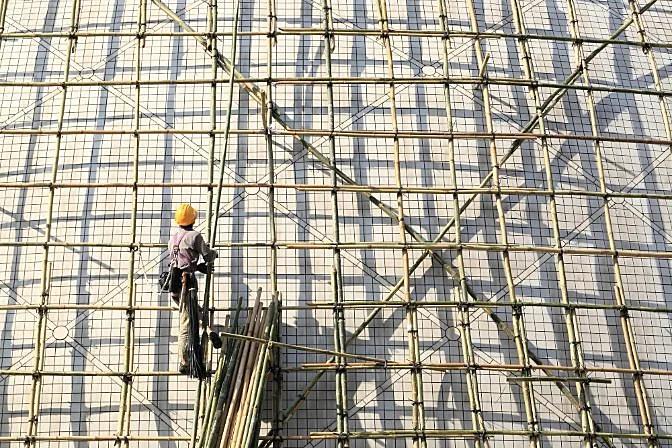Affordable Domestic Scaffolding for Every Home Renovation Project
Affordable Domestic Scaffolding for Every Home Renovation Project
Blog Article
The Advantages of Scaffolding for Security and Efficiency in Structure Projects
Scaffolding is an important part in the realm of building and construction, substantially adding to both security and operational efficiency. By supplying protected systems and improved accessibility to raised workspace, scaffolding not only reduces autumn threats however also boosts the operations for building groups. Its adaptability permits adaptation throughout different task types, ensuring conformity with safety laws. Nevertheless, the impact of scaffolding expands beyond fundamental safety and security steps; its critical execution can change project timelines and outcomes. Exploring these diverse advantages reveals insights that are essential for any type of construction professional.
Enhanced Employee Safety And Security

Improved employee safety and security is a vital issue in the building industry, where the threats related to falls and accidents can have alarming effects. Efficient scaffolding systems play an essential duty in minimizing these hazards by giving steady systems for workers at elevated elevations. By ensuring that scaffolding is correctly set up and kept, building and construction firms can considerably minimize the chance of drops, which are among the leading causes of work environment injuries and deaths.
Furthermore, scaffolding improves safety and security via its layout features. Guardrails, toe boards, and non-slip surfaces contribute to a protected working atmosphere, decreasing the risk of accidents. Additionally, scaffolding allows workers to access hard-to-reach areas without the need for makeshift services, which can jeopardize security requirements.
Educating workers on the appropriate use of scaffolding is equally essential. Guaranteeing that personnel are educated concerning lots abilities, setting up procedures, and safety protocols better boosts the performance of scaffolding in avoiding accidents. Finally, incorporating durable scaffolding systems within building jobs not only boosts employee safety yet also advertises a society of safety that profits the entire workforce while enhancing total productivity.
Improved Access and Flexibility

Furthermore, scaffolding permits the hassle-free transport of products and devices, decreasing downtime related to relocating tools. Workers can efficiently access various areas of a project, which is particularly important in complex builds where upright and straight activity is regular - Scaffolding. This access not only streamlines operations however likewise enables groups to react promptly to changing task demands
Furthermore, scaffolding can be tailored to fit certain website conditions, improving movement in uneven or limited areas. This versatility makes sure that building activities can continue smoothly, no matter the obstacles provided by the atmosphere. By fostering improved accessibility and flexibility, scaffolding plays an important role in supporting building and construction crews and maximizing the total performance of building jobs.
Enhanced Task Effectiveness
In construction, project performance is dramatically influenced by the efficient use scaffolding systems. By supplying a safe and secure platform for employees, scaffolding reduces downtime and increases the pace of building and construction activities. With enhanced access to raised workplace, groups can complete tasks faster, reducing the total job timeline.
The modular nature of modern scaffolding enables rapid assembly and disassembly, making it possible for swift shifts in between different phases of a task. This flexibility not only improves operations but likewise adds to better sychronisation amongst various trades, as numerous teams can work all at once on different sections of a structure.
In addition, scaffolding ensures that workers are located appropriately to perform their jobs without unneeded pressure or risk of injury, thus minimizing the chance of crashes that can lead to costly delays. Improved safety steps embedded in scaffolding systems, such as guardrails and toe boards, additional assistance reliable procedures by keeping employee concentrate on the job handy as opposed to security issues.

Versatility for Numerous Tasks
Scaffolding systems stick out for their adaptability throughout a vast range of building tasks, with the ability of meeting details website requirements and jobs. Their modular layout enables quick modifications to suit various structure types, from domestic to business frameworks, ensuring that workers have risk-free gain access to at various elevations and angles.
These systems can be customized for diverse applications, such as façade job, indoor renovations, or durable industrial jobs. Light-weight light weight aluminum scaffolds are ideal for interior work, while robust steel frameworks provide the necessary support for large-scale building and construction. The flexibility of scaffolding prolongs to its capability to be configured for both long-term and short-term structures, allowing contractors to efficiently intend and implement their projects.
Furthermore, scaffolding can be employed in challenging settings, consisting of metropolitan settings where space is minimal or on irregular surface where conventional access solutions are not practical. This adaptability lessens the requirement for multiple accessibility options, minimizing costs and task timelines. By suiting a range of problems and jobs, scaffolding enhances the total performance and efficiency of construction initiatives, verifying to be an important asset in the structure industry.
Conformity With Security Standards
How can construction jobs guarantee the safety and security of employees while maintaining efficiency? Regulatory structures, such as OSHA in the United States, give guidelines that regulate the usage of scaffolding, making certain that it meets rigorous security requirements.
Correct scaffolding layout and installment play an essential duty in conformity. Educating workers on safe scaffold use and the importance of conformity with safety and security criteria additionally strengthens a culture of safety on-site.
Additionally, documents and record-keeping pertaining to security assessments and worker training are vital. These techniques not just show conformity however also provide liability and transparency. Ultimately, by focusing on adherence to security standards, construction tasks can promote a safer work environment, therefore boosting productivity and performance without jeopardizing worker safety and security.
Conclusion
Finally, scaffolding functions as an important part in building tasks, substantially improving safety and security and efficiency. Its layout functions, consisting of guardrails and non-slip surfaces, add to a safer working setting while helping with better gain access to and flexibility for workers. The modular nature of scaffolding promotes quick assembly, therefore increasing general task efficiency. Adherence to safety requirements emphasizes the importance of scaffolding in accomplishing successful job end results, making it indispensable in the building sector.
Scaffolding is a crucial part in the world of construction, significantly contributing to both safety and operational efficiency. The impact of scaffolding extends beyond fundamental security procedures; its calculated execution can change job timelines and results. In final thought, integrating robust scaffolding systems within construction projects not just boosts employee safety and security yet additionally advertises a culture of safety that benefits the whole labor force while improving general productivity.
In conclusion, scaffolding offers as a crucial element in structure jobs, considerably learn the facts here now enhancing safety and performance. Adherence to security standards underscores the relevance of scaffolding in accomplishing successful project end results, making it important in the construction try this site sector.
Report this page